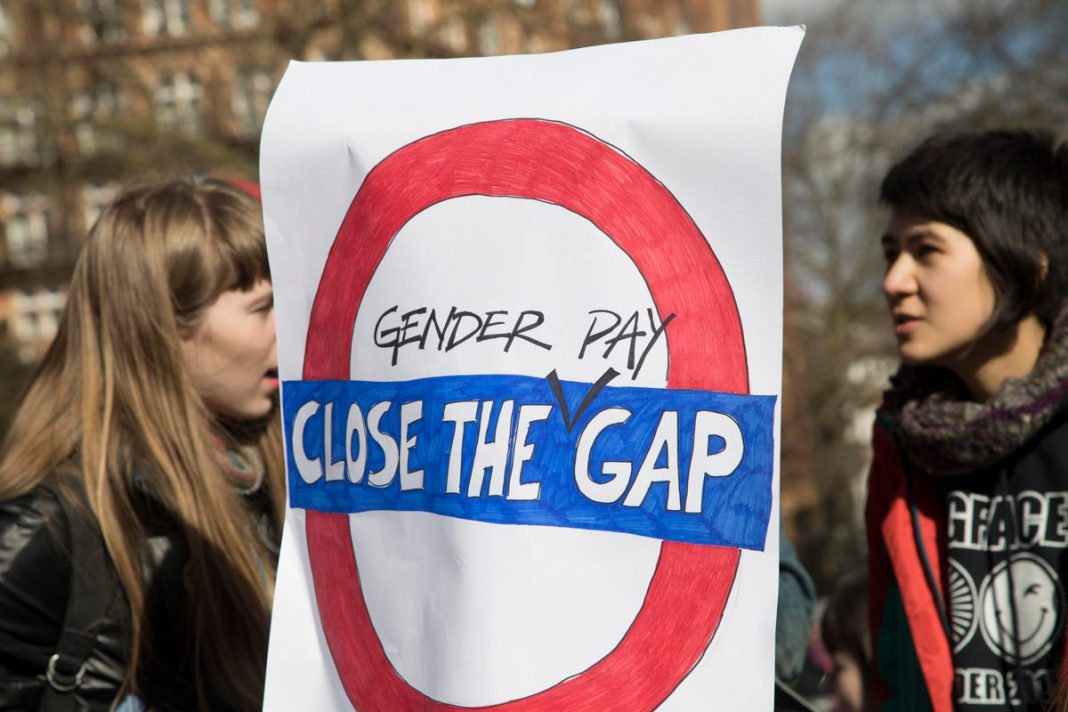People gather in Russell Square for the Women’s Strike Assembly in 2018 in London, England, United Kingdom. A new report finds that a focus on the median pay gap between men and women may have unintended consequences. (Photo by Mike Kemp)
In Pictures via Getty Images
There’s an old management adage that everyone has heard: What gets measured gets managed. And while that’s often a good thing—focusing on a metric means the issues behind it get the resources they need—it can also have unintended consequences.
That’s what’s happened with the pay gap, argues a new analysis released Wednesday by S&P Global, a provider of ratings, benchmarks and analytics. The report analyzes the gender wage gap over the last 15 years, when the ranks of female executives have grown and focus has increased on measuring the pay gap. It finds that women are more likely than men to be paid in a tight range around median figures, and as a result, are not only underrepresented among the lowest paid executives, but much less likely to be paid at the top range, too.
The findings suggest companies have been overly focused on the “optics” of the issue—how their pay practices will be viewed by the public as scrutiny has grown—rather than on solving the issue, says Daniel Sandberg, senior director of quantamental research at S&P Global Market Intelligence.
“If you’re explicitly looking at how [women] compare to a benchmark and that’s the deciding factor of whether they get a raise and how much—if you’re doing that for women and you’re not doing it with the same degree of attention for men—then that’s a problem,” Sandberg says. “That’s not equitable. That’s a different set of rules for two groups.”
The report looked at pay figures disclosed in SEC filings for about 25 executive roles at Russell 3000 companies. It found that while the median pay ratio between men and women has steadily increased in recent years, the average pay ratio has actually gone down, meaning there are more outlier paydays for men than women. “Effectively, women have been given a glass floor as redress for the still-present glass ceiling,” Sandberg writes in the report.
We spoke with Sandberg about his research and what leaders should do as a result. Excerpts from the interview have been condensed for length and clarity.
Jena McGregor: Why did you do this research?
Daniel Sandberg: Our aim with this study was to basically quantify the gender pay gap, and we started to look at our [data] around compensation. What we ended up finding was far more interesting than just quantifying the numbers on where we are with the pay gap. The analysis suggests firms are managing the compensation of women to address this metric—the median—which is commonly watched and is commonly reported when it comes to pay equity. The way that firms are managing to [the number] is actually increasing the disparity in pay between genders. I found no record of this in the literature being reported anywhere else.
McGregor: Is this actually the approach–setting pay by relying on median benchmarks—that companies are taking when setting pay for women?
Sandberg: I’m an empiricist, so I don’t have that insight. But this is what the data indicates. The intentions obviously have to be inferred.
Let me first share an analogy. Let’s say three men go to a restaurant, sit down and order something to eat. The first orders a $1 bowl of ramen. The second orders a $10 salad, and the third orders a $100 steak dinner. The middle [median] item for that table is the $10 salad.
Now, three women sit down at the same restaurant. They all order the $10 salad. The median for their table is also that $10 salad. But the check for the table of three men is $111 while the check for the table of three women is $30. Because the high-end item, the $100 steak dinner, is so much farther from that midpoint than the low-end item, the table of women has a lower dollar value.
That’s what we’re seeing with compensation. There’s so much emphasis placed on the median salary for women compared to men. We see the compensation for women consolidated and compressed around this median, and that’s been a net disadvantage for women. The women in our study collectively are earning less compared to men today than they were 15 years ago, despite the fact that the median salaries for the two genders are converging.
Basically, women are getting that $10 salad equivalent salary, which is better than the $1 ramen. But it’s not as good as the $100 steak. That’s the behavior that we’re calling gender-based compensation management.
The “Fearless Girl” statue was installed in front of the bronze “Charging Bull” in New York in 2017 to draw attention to the gender pay gap and lack of gender diversity on corporate boards before being moved to another location. (Photo by Volkan Furuncu)
Getty Images
McGregor: Does the same effect happen for men? Isn’t there a broader effort by boards to say ‘we can defend $15 million paydays because that’s what our median competitor is paying, too’?
Sandberg: A survey I cited in the paper indicates 75% of firms have admitted they buy compensation benchmark data to help set pay. So there’s no denial or disagreement that firms are using benchmarks to set pay. And nothing in my research indicates the use of benchmarks is good or bad. What my analysis shows is that the benchmarks are more stringently being applied to women than men.
McGregor: Why do you think this is happening?
Sandberg: This is what’s being watched. The median is being heavily reported. I think the data indicate that firms are acknowledging this focus on the median and making those the numbers that they’re addressing.
McGregor: Could there be other explanations? Could it be a sign of women negotiating less for the biggest pay, an issue that’s often raised?
Sandberg: I cannot think of another explanation. We don’t have the data to establish intentions. I think that there is a focus on this metric, the median. If you’re below this metric as a woman, you get moved up. If you’re above this metric as a woman, you are basically viewed as not in need of being moved up.
McGregor: If you’re a human resources or board leader or CEO reading this, what can you do about it? What should they change?
Sandberg: I’m not a policy expert. I’m not an H.R. expert. But these aren’t just numbers on a page. If we know the numbers then we can act to change the numbers.
Transparency is a huge part of solving the problem. Data and analytics that go beyond a single number are a huge part of solving the problem. It’s not just about the median or the mean. It’s about understanding the whole distribution.




